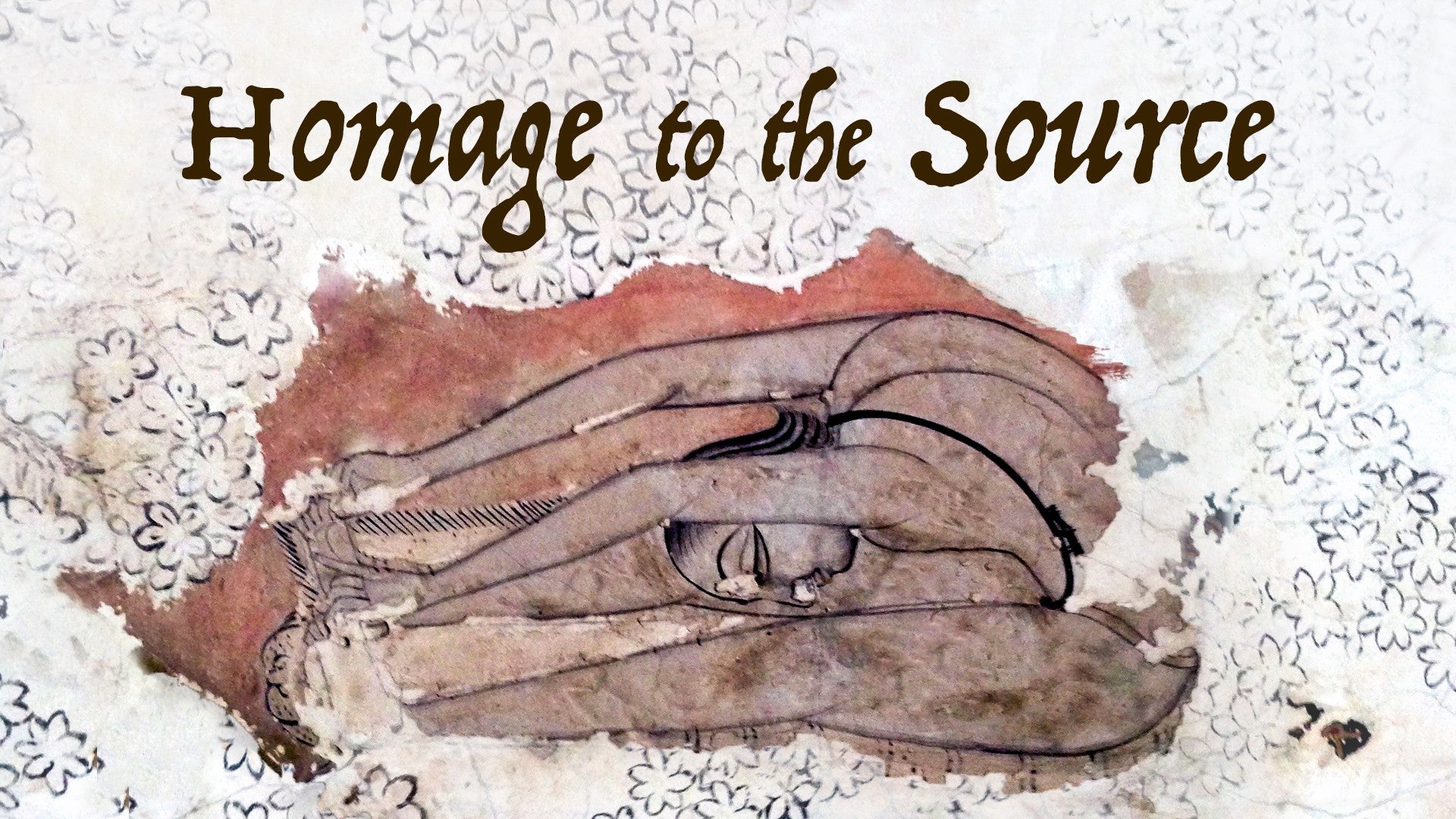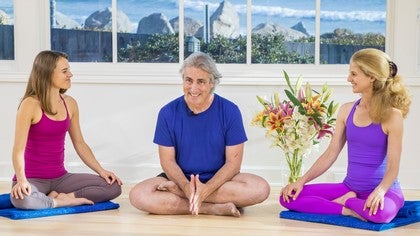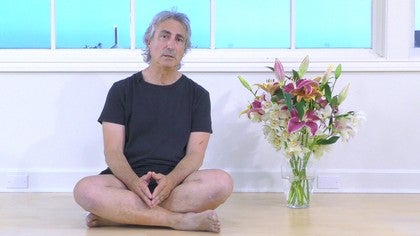Description
About This Video
Transcript
Read Full Transcript
Hi, we're here with our friends Betsy and Alana, and we're going to talk a little bit about Hatha yoga. Now you may think that the way I'm pronouncing the word Hatha is a little odd. It's usually pronounced Hatha, which is acceptable, although it's not exactly accurate. The T in that word is what's called a retroflex letter. And what you have to do in that case is turn your tongue back in your mouth and flick it off the roof of the mouth.
And so it comes out Hatha. And so we're going to talk about Hatha yoga here. And if we ask the average student to translate the Sanskrit word yoga into English, she'll likely answer with the word union. Now this is an okay answer, but it doesn't tell the whole story for three reasons. First, if we look up yoga in a Sanskrit English dictionary, we'll find that it has a whole bunch of meanings.
Some of which we expect like union. Others that are a little surprising like trick, deceit, and wealth. We also see that yoga means a way or method. A reminder that originally this word was used in reference to a very important part of an ancient charioteer's job, getting a couple of feisty war horses hooked up to a chariot. This wasn't an easy task to do.
And so the charioteer needed a specific method to help him reach his goal, which of course was yoking or union. That is of the horses with the chariot. So to be precise, the definition of yoga should ideally be something like union method. The former word acknowledges the goal of most schools of yoga. While the latter word recognizes that in order to reach that goal, we need to have an appropriate practice.
Now these practices are many and varied. There are at least two dozen traditional schools of yoga, each of which has a different approach, but almost all have the same goal. These differences are designed to suit the preferences and natural abilities of different people. Some might prefer working with the intellect, others with devotion, others might find their calling and selfless service to the world, although there's no reason why one can't practice all three of these methods together. But there's even a tale of a man who despised the deity Vishnu with such an unsparing intensity that he became enlightened.
Yoga anytime doesn't endorse this practice, which is known as samramba yoga, the yoga of fury. We'll come back to the subject of yoga schools shortly. The second shortcoming of yoga as union involves the school of classical yoga, which is based on the yoga sutra, attributed to its presumed compiler Patanjali. Now this text has been interpreted by many commentators in a way that defines its goal as union, and there's absolutely nothing wrong with this. But the original goal of classical yoga, which involves a very intense form of meditation, isn't union but harnessing, which is another definition of yoga entered in the dictionary.
Like the charioteer skillfully bringing the snorting kicking horses under his control, in this practice we do the same to the incessant chattering of our consciousness. This helps us to achieve two things. One, distance ourselves from and then rid ourselves of, our exclusive but mistaken association with our limited and limiting ego self, the source of so much existential suffering. And two, to reorient ourselves to our true self, who Patanjali calls purusha, man, or drashtir, the seer. The third problem of yoga as union concerns the dominant philosophy of most yoga schools.
This is Vedanta, literally the end, anta, of the Veda, the word end having two implications. One, the books on which this teaching is based, the Upanishads, come at the physical end of the Vedic canon. And two, Vedanta represents the end or culmination of the Vedic teaching. Philosophically, Vedanta is generally monistic, which means that it views all the nearly infinite diversity of the universe as being ultimately united in the absolute, usually called Brahman. Everything, in other words, is one thing.
And there's the rub. In order to have a union, we need two things. In regard to traditional yoga, these two are usually named the embodied self and the supreme self, or in Sanskrit, Akman and Brahman. But Vedanta says these two are only seemingly so. In actuality, they're forever one.
So to be precise then, the realization of yoga in this view doesn't create a union, as is often suggested, because it's impossible for Akman and Brahman to ever be separate. It simply reveals the union that's always been there, of which we in our spiritual blindness have been unaware. We should remember then that yoga isn't a path or a journey, because there's nowhere we need to go. We are, in effect, already at our destination. As I noted earlier, there are a good two dozen traditional yoga schools, which were schools that were all in existence well before the 20th century.
But only about six or seven of these are major schools. One of these is Hatha Yoga. If we go back to our average student and ask her to put Hatha in English, she'd likely say that it means something like sun, moon. This isn't, however, a literal translation of the word. It's rather a fanciful interpretation, the syllable ha standing for the sun and ta for the moon.
The reference here is to the pair of energies, the heating and cooling, that power our lives and that Hatha practice aims to balance and integrate. The dictionary definition of Hatha is forced or forceful, so Hatha Yoga is literally the forceful union method. We have to be careful, though, with how we understand the word force. There are times in our practice when we can push ourselves beyond what we consider to be our limitations, but at the same time we also need to know when it's time to not do or let go. So be sure to always modify force with the word appropriate.
When to push and when to back off is something we need to learn to experience and from the wise advice of our teachers. Hatha emerged sometime around the 10th or 11th century of the common era, influenced by both Hindu tantra and Indian alchemy. For the first four or five hundred years of its existence, it didn't look at all like what we call Hatha today. The practice was strictly a sitting practice and Asana in those days was exactly what the word means, seat, primarily for breathing and meditation. The focus was on extending life way beyond the typical span of years through the preservation of the precious elixir or nectar of immortality named Amrita, literally no death, and the waking of the mysterious dormant serpent power, Kundalini, the coiled one.
Far more important to these ends than Asana were the seals or mudras and bonds or bandhas which the yogi used to seal the energy in and channel it through the body. We see the first non-seated Asanas in the Hatha Pradipika or as it's popularly known, the Hatha Yoga Pradipika, which was compiled sometime in the mid-1400s by someone named Swatmarama. I say compiled here because the text is basically a collection of verses drawn from about 20 other texts, all without attribution. This, of course, would land Mr. Swatmarama in hot, boiling water. Nowadays, lawyers nipping in his heels, but it was common practice among yogis in those far-off times.
There are 15 Asanas included in the Pradipika, many of them familiar to us today, though some of the familiar names are applied to poses that are completely different than their modern versions. For example, Garudasana, the so-called eagle pose, nowadays is a standing pretzel-twisted position, but 500 years ago it was a sitting pose with the feet off to the sides of the hips and diverted that is pressing against the floor on their inner arches. Many students today associate Hatha Yoga only with Asanas and think of it as nothing more than a good physical workout, which it undeniably is in the way it's presented in most schools. But in the Pradipika's time, while Asana was an important component of the practice, it was never an end in itself. The poses were a means to an end, which was to strengthen the body and open the energy channels in preparation for long bouts of sitting, for breathing and meditation.
Unlike today, when the goal of yoga might well be tight buns or relief from stress of a nine-to-five job, 500 years ago a successful practice resulted in mukti or liberation. Over the next centuries, the number of poses increased gradually. 200 years down the road from the Pradipika, the Garanda Samhita included 32 Asanas, the Hatha Ratanavali, about 55. The 18th century Yoga Pradipika, not to be confused with the Hatha Pradipika, written not in Sanskrit but in a dialect of Hindi, included 84 Asanas. In the 19th century, Sri Tatvaniti, 112.
As we all know, when Hatha reached the 20th century, it underwent a complete makeover and went international. Several of the old practices were dropped as being too dangerous for modern practitioners, and a truckload of new Asanas were brought in to take up the slack. Many of these Asanas came from western gymnastics and Indian wrestling, and were given appealing Sanskrit names to make them seem more yogic. The splits, for example, became Hanumanasana, and arm strength and wrestling exercise became Lolaasana, the dangling pose. I'm often asked where yoga is heading in the future.
Will it become just another health club favorite? Or will it return to and revive its spiritual roots? We have to remember that in the grand tradition of yoga, which extends at least 2500 years back in time, we in the West are just babies, figuratively lying in our cribs, wiggling our fingers and toes. We're often accused by traditionalists of degrading yoga into a merely physical practice. But we have to remember that this is, first, entirely age appropriate for us babies, and second, that it's been acknowledged for many hundreds of years that Hatha is indeed a beneficial physical practice.
My reply to the question is always, yes indeed, we will at some point in the future, maybe in ten years, maybe in a hundred, find our way back to yoga's spiritual roots, though we'll express them in new ways that take into account modern western needs and aspirations. What about the charge that we're degrading yoga, and we'll eventually destroy it? No chance of that. Since yoga is innate in our very being, it's part of who we are as conscious beings, and if it can be destroyed, then it isn't yoga. Thank you.
Homage to the Source
Comments
You need to be a subscriber to post a comment.
Please Log In or Create an Account to start your free trial.










